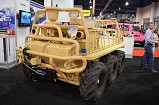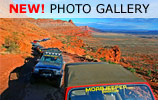 |
||
| > Reader's Photo OX5 by Lockheed Martin |
||
| • ADVERTISE WITH US | ||
| • WHO IS MOAB JEEPER? | ||
Home > Jeep Articles > General - Extras > Pressure? What's in your tires? |
||||||||||||||||||||||||||||
 |
||||||||||||||||||||||||||||
|
Pressure? What's in your tires?Article written by Moab ManDate Added: 03/15/2009 Tire pressure, and what it does for you, is underappreciated. Treat it right and your tires will take care of you. Cross it... and it may cost you financially and physically. |
When set at the correct tire pressure, you improve the safety and handling of your vehicle. Driving on road with under inflated tires risks damage to the tire and a possible blowout. Over inflate, and you reduce traction. Either of these situations will seriously reduce the life of a set of tires and quite possibly your day - in a worse case blowout. |

|
|
Of course what tire pressure is correct can easily be answered by never changing from your stock tire size. However, you're probably not here reading MOABJEEPER Magazine and still running stock tires, or planning to stay with stock tires. |

|
|
Let?s start with installing some new, larger tires at a local tire shop; professionals? Tire pressure for stock sized tires is 33 psi, but we're jumping up to 33's. |

|
|
If you are running stock tires, and you're unsure of proper pressure; it can be found on a tag located in the door jam of your vehicle or your glove box door. Or you can always check in your owner?s manual. |

|
|
Collectively, our first assumption is that a "tire professional" would inflate tires to something reasonable. This would be the first mistake if you don't check your tire pressure yourself. Once our new tires were mounted, we immediately took a tape measure to the vehicle to see how much actual height we had just lost from the 35's previously mounted. Amazingly, we hadn't lost any height, so we immediately knew something was wrong. A quick check with the tire pressure gauge, and our tire professionals had sent us on our way with 60-62 psi in each tire. Nothing is more satisfying than spending 600-1200 dollars for tires and having them ruined by someone that has no accountability or requirement to replace them. Lesson one, check your tire pressure immediately after they?re mounted. |

|
|
So far we have proven again the age old adage, "if you want something done right, then do it yourself." This of course begs the question, what tire pressure do I use for my new, substantially-larger-than-stock tires? Are you wondering why you should be asking this question and not using the recommended manufacturer?s tire pressure? We'll tell you. A larger tire will support more weight with less effort than a smaller stock tire. This is because the vehicle?s weight is supported by both the pressure and the volume of the air inside the tires. Bigger tires have more air and thus need less pressure. How much les depends on the shape and size of the tire, and each tire is going to have a different ideal pressure to have proper form and maximum safe tire contact with the road surface. |

|
|
We will now reveal the highly technical tool for acquiring a proper tire contact measure, CHALK. You can of course purchase it from your local Walmart store, but we chose to enlist the help of a child and her far superior chalk coloring skills.
Caution: We of course never recommend trying to enlist the help of a child that does not belong to you, but stealing the kid?s chalk may work if you're fast enough to get away and there aren't enough of the munchkins around to take you down. |

|
|
Step 1: Locate a level smooth surface allowing 100 feet of straight driving. Step 2: Your skilled professional sidewalk chalker should now fill in a row of tread blocks.
Step 3: Drive the vehicle 100 feet or so and check the chalk line. You may need to drive it back and forth a couple times depending on the tires/road surface to get a good readable wear on the chalk. |

|
|
Getting Lucky! We admit it, we guessed right and got lucky on the first attempt at 30 psi for this particular tire. Pictured, we have a nice uniform line of chalk wear. The chalk does get a little heavier at the very edge of the tread, but you must find a balance. Trying to get the last little bit of shoulder chalk to wear caused the tire to be under inflated. |

|
|
Under Inflated In pursuit of full contact; we tried to go a little lower tire pressure but started to lose uniformity of wear. You can see in our picture where the shoulders started to wear the chalk off much faster than the center. Over time the same thing would happen to the tire tread. The low pressure in our tire made the center tread line less rigid than the sidewalls of the tire, so the vehicle was essentially being supported by the sidewalls. |

|
|
Over Inflated Since the sidewall cannot stretch, the center line of the tire bows outward. This causes the weight of the vehicle to ride heavier down the ballooned, middle portion of the tire. Our picture shows the greater chalk center line chalk wear. |

|
Final ThoughtsOf course none of us buy our off-road tires to chew them up on the road, leaving us nothing for off-road. Take the time and figure out the right tire pressure for your particular vehicle with the specific tire you're running. A particular tire pressure for one size of tire will not necessarily be correct for the next, nor will it be the same for two tires of the same size of different brands. For example, our set of BF Goodrich tires has a much stiffer sidewall than our set of Goodyears. Equal size but different construction will change the way the tire makes contact.While we have concentrated on tire pressure for proper wear, this is a good time to also acknowledge wheel width. A tire with a 12.50" width can be put on a wheel that is 8 or 10 inches wide. Both sizes are acceptable, but a 10" wide wheel will allow the tire tread to sit more squared to the wheel and pavement. An 8" wheel causes a slight bowing of the tire down the center line. Point is, tire pressure will not be the same just because of the difference in wheel sizes, everything else being equal. On the opposite end of getting a proper contact is lowering you tire pressure to get the most tire contact with the wheeling surface. If you would like to read up on what low pressure is doing for you off-road visit:
How low should I go? | |
|


